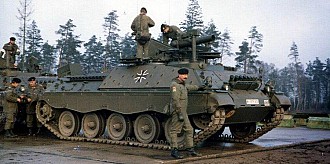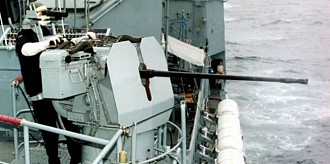Combat vehicles / Infantry fighting vehicles / Marder
Marder
General Facts
- TYPE
Mechanized infantry combat vehicle - ORIGIN
 Germany
Germany - NICKNAMES
- - DESIGNED
1960 - 1971 - DESIGNER
Rheinstahl group - PRODUCTION
1971 - 1975 - PRODUCERS
 Germany - Kraus Maffei Wegmann
Germany - Kraus Maffei Wegmann - QUANTITY
2.136 - UNIT COST
Unknown - CHARACTERISTICS
 High level of protection
High level of protection
 Good firepower
Good firepower
 Non-stabilized armamaent
Non-stabilized armamaent
 Average speed
Average speed
Introduction
The Marder is a mechanized infantry fighting vehicles of German origin. It was designed in the 1960's to replace the HS-30 in German service, which showed poor performance. Marder is German for marten and fits in with the tradition of naming armored vehicles after cat-like animals. The Marder was continuously upgraded over time and was one of the main combat vehicles opposing the Soviet forces in Europe during the Cold War.
Layout
The Marder shares many components with the Jagdpanzer Kanone and Jaguar, from which the chassis was derived. The layout is conventional with the engine at the front and the driver on the left. In the middle the recessed turret is fitted which houses the gunner and the commander. The troop compartment at the rear has six seats facing outwards.
Firepower
The Marder is fitted with a recessed two man turret, which almost classifies as an overhead weapon system. A 20mm Rh-202 autocannon is fitted. At first these were single feed, but the dual feed option was added and allows for easy switching between armor piercing and high explosive rounds. A MG3 machine gun is mounted coaxially. From his hatch the commander is able to fire the pedestal mounted manpack Milan anti-tank missile. Early models had a remote controlled MG3 at the troop compartment.
Protection
The steel armor protects the crew against everything up to and including 14.5mm rounds fired from point blank range. All Marders were subsequently upgraded with additional armor to protect against bomblets and the 30x165mm rounds fired by the BMP-2. The latest upgrades improve survivability against mines. An NBC system is fitted, as well as six smoke grenade launchers.
Mobility
The tracked chassis makes the Marder very mobile, which is necessary as the Marder was to accompany the Leopard 1 and 2 main battle tanks on the battlefield. A 600hp diesel engine provides propulsion. The Marder is not amphibious.
Users
The main user of the Marder is the German army. A reduced number remains in use today. Recently surplus vehicles were sold to Chile. The Marder has seen combat service in Afghanistan.
Marder 1
The original Marder 1 came in various versions, each with a number of minor improvements. Over time all Marder 1's were upgraded to a single type called the Marder 1A2. The upgrades include dual feed for the 20mm autocannon, night vision equipment, improved radios, improved sighting system, removal of the remote controlled MG3 over the crew compartment, remodeled interior and improved suspension. The Marder 1A3 is a major upgrade over the previous models. The armor has been improved significantly and external stowage has been added. This makes the firing ports no longer useable. The Marder 1A4 is similar to the A3, but has been fitted with an improved radio. A small batch of Marders have been upgraded to the A5 standard. This latest version of the Marder has improved mine protection and a remodeled interior which provides a much better protection against shock, blast and spalling.
- Specifications:
- Marder 1
- Marder 1A3
| Type | Mechanized infantry combat vehicle |
|---|---|
| Crew | 3 + 6 (commander, driver, gunner, 6 infantry) |
| Length | 6.79 m |
| Width | 3.24 m |
| Height | 2.99 m (turret top) |
| Ground clearance | 0.44 |
| Weight | 28.2 t unloaded, 29.2 t combat load |
| Ground pressure | 0.83 kg/cm2 |
| Wheelbase | Tracked chassis, 6 roadwheels, drive sprocket front, idler rear, 3.9 m length, 0.45 m width, 2.62 m track |
| Turn radius | 6.5 m |
| Engine | MTU MB 833 Ea-500 V6 diesel, 600 hp at 2.200 rpm |
| Power ratio | 20.6 hp/t |
|---|---|
| Transmission | HSWL 194 planetary, 4 forward, 2 reverse |
| Speed | 75 km/h |
| Fuel | 652 L |
| Range | 520 km |
| Wall | 1 m |
| Trench | 2.5 m |
| Gradient | 60% gradient, 30% slope |
| Fording | 1.5 m unprepared, 2.5 m with preparation |
| Armor | Steel |
| NBC equipment | Yes |
| Night vision | Yes |
|---|---|
| Smoke | 6x 76mm smoke grenade dischargers |
| Remarks | - |
| Armament | 20mm Rh-202 autocannon 7.62mm MG3 machine gun |
| Weapon1 | 20mm Rh-202 autocannon in turret 1.250 rounds -17 to +65° elevation, 40°/s powered 360° travers, 60°/s powered non-stabilized |
| Weapon2 | 7.62mm MG3 coaxial machine gun 5.000 rounds traverse and elevation as main armament |
| Weapon3 | - |
| Weapon4 | - |
| Weapon5 | - |
| Weapon6 | - |
| Type | Mechanized infantry combat vehicle |
|---|---|
| Crew | 3 + 6 (commander, driver, gunner, 6 infantry) |
| Length | 6.88 m |
| Width | 3.38 m |
| Height | 3.02 m (turret top) |
| Ground clearance | 0.46 |
| Weight | 29.9 t unloaded, 33.5 t combat load |
| Ground pressure | 0.94 kg/cm2 |
| Wheelbase | Tracked chassis, 6 roadwheels, drive sprocket front, idler rear, 3.9 m length, 0.45 m width, 2.62 m track |
| Turn radius | 6.5 m |
| Engine | MTU MB 833 Ea-500 V6 diesel, 600 hp at 2.200 rpm |
| Power ratio | 17.9 hp/t |
|---|---|
| Transmission | HSWL 194 planetary, 4 forward, 2 reverse |
| Speed | 65 km/h |
| Fuel | 652 L |
| Range | 500 km |
| Wall | 1 m |
| Trench | 2.5 m |
| Gradient | 60% gradient, 30% slope |
| Fording | 1.5 m unprepared, 2.0 m with preparation |
| Armor | Steel |
| NBC equipment | Yes |
| Night vision | Yes |
|---|---|
| Smoke | 6x 76mm smoke grenade dischargers |
| Remarks | - |
| Armament | 20mm Rh-202 autocannon 7.62mm MG3 machine gun Milan missile launcher |
| Weapon1 | 20mm Rh-202 autocannon in turret 1.250 rounds -17 to +65° elevation, 40°/s powered 360° travers, 60°/s powered non-stabilized |
| Weapon2 | 7.62mm MG3 coaxial machine gun 5.000 rounds traverse and elevation as main armament |
| Weapon3 | Milan missile launcher on turret 5 missiles, 1 round ready to fire manual traverse and elevation non-stabilized |
| Weapon4 | - |
| Weapon5 | - |
| Weapon6 | - |






